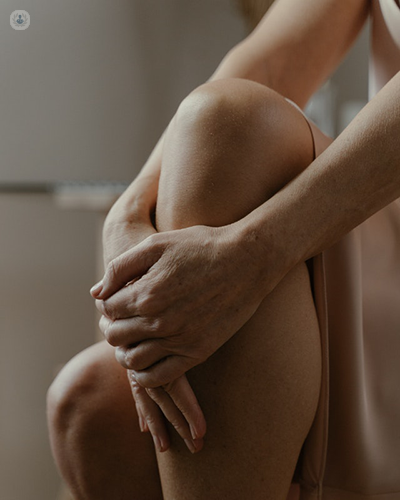What’s causing my knee pain? Ask an expert
Autore:It’s only when sudden knee pain strikes that we realise how often we take good joint health for granted. The numerous ligaments, muscles and bone sections that work together within the knee usually give us fluid movement. When things are not running smoothly within this system however, pain or discomfort and difficulty with walking or daily movement indicates that there is a problem, usually pretty quickly. In this article, leading consultant orthopaedic surgeon Mr Christopher Arthur Bailey expertly outlines the five most common causes of new and unexpected knee pain.

1. Injury
The most common cause of new and unexpected pain in the knee is undoubtedly injury. Most people with this type of knee pain are aware of the exact moment they sustained the injury and the resulting knee pain; a rough tackle in a football game, a fall or an uncomfortable twisting movement. These types of accidents most commonly result in the following injuries to the knee:
- Fractures – a hard impact can break the kneecap (patella), shinbone (tibia) or thighbone (femur)
- Meniscus tears – damage to cartilage within the knee joint
- Ligament tears – tearing of one of the strong tissues that connect the bones of the knee together (ACL, MCL, PCL)
- Tendinitis – a stress reaction in one of the tissues that connects muscles to bones
As well as these, other types of injuries to the mechanics of the knee can also occur. Small bits of bone or cartilage can break off for example, causing the joint to catch or to lock. Dislocation of the knee, (patellar sublaxation) where the kneecap pops out of its natural location, can also occur. Any type of injury to the knee typically causes pain but other symptoms can vary. Taking scans helps to identify which part of the knee is injured and how severely.
2. Activity
Trying out a new sport, activity or changing your routine in some way may be the cause behind knee pain. A common example might be a DIY project done over the weekend that involves a lot of kneeling which leaves you with knee pain in the days that follow. The cause behind this may be bursitis, an irritation and swelling of the protective sac within the knee joint.
Going out for a run in different conditions than usual, or attempting a greater distance than usual on new terrain, for example, can cause a stress reaction within the knee leading to pain (tendinitis).
Pain caused by activity can also lead the discovery of undiagnosed conditions present in the knee, such as a degenerate meniscus which reaches breaking point or the onset of osteoarthritis.
3. Osteoarthritis
Osteoarthritis occurs when the layer of cartilage on the ends of the bones, which normally prevents the bones from grinding against each other, becomes too thin. It is referred to as ‘wear and tear arthritis’. Symptoms commonly include:
- a dull ache
- pain after activity
- pain during the night
The condition can develop slowly over years but the onset of pain can be quite sudden meaning that patients are often surprised when the diagnosis is arthritis.
4. Inflammatory arthritis
As opposed to ‘wear and tear’, some types of arthritis derive from an inflammatory issue. Rheumatoid arthritis, the most common inflammatory related arthritis, is an autoimmune condition which can affect any of the body’s joints.
Patients who suffer from rheumatoid arthritis commonly have sudden flare-ups, where symptoms suddenly worsen and then improve. Unlike osteoarthritis, joint pain for sufferers of rheumatoid arthritis is typically worse in the mornings. Conditions such as gout, pseudogout and septic arthritis are other forms of inflammatory arthritis.
5. Infection
Although infections in the knee are uncommon, it is important to rule them out as they can progress very quickly and can be serious. It’s important to note that knee infections usually don’t originate from a cut on the knee itself, but rather transfer through the blood from another area of the body. Even teeth brushing and athlete’s foot can lead to a knee infection.
Infections can be viral, often less harmful, or bacterial, which more often have nastier consequences. Important red flags for knee infection to note are:
- heat or redness in the area
- swelling in the knee
- fever
- high temperature
You should seek medical attention immediately if you think you are suffering from a knee infection.
If you are concerned by knee pain or a knee injury, you can book a consultation with Mr Bailey by visiting his Top Doctors profile.


